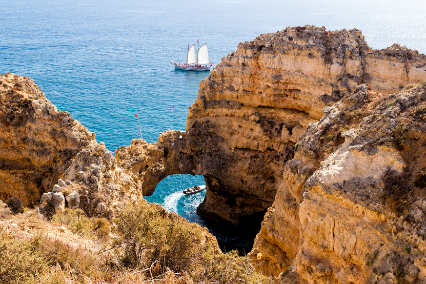Published 2nd Aug. 2023
Reading time
The hungry traveller feels instantly at home in Portugal; the land of hearty, homecooked fare, extra-special sandwiches and some very famous custard tarts. Neighbouring Spain might have historically hogged the culinary spotlight, but Portugal is now firmly on the foodie map thanks to its delicious and distinctive dishes (which pair oh so well with its world-class wines). So, if you’re wondering which classic dishes the Portuguese turn to when they’re peckish, here are our picks of the tastiest traditional food in Portugal.
Even if you haven’t visited Portugal yet, you’ve probably spotted pastéis de nata in your local bakery, coffee shop or supermarket. These wildly popular Portuguese tarts have a crisp, layered crust of pastry and an oozy custard filling flavoured with cinnamon and lemon zest. And although they are one of Portugal’s best-known culinary exports, they always taste better in their home country. Originally invented at the Mosteiro dos Jerónimos in the Belém district of Lisbon (the tarts are also called pastéis de Belém), the secret recipe passed to a local shop owner when the monastery closed briefly in the early 19th century. Today, the same Pastéis de Belém shop continues to draw the hungry hordes, with long queues of pilgrims waiting patiently to purchase their pastéis. The shop sells around 20,000 tarts a day, but you can find these treats all over Lisbon (and Portugal) if you want to avoid the crowds.
Many people consider caldo verde (green soup) to be the unofficial national dish, so if you want to try traditional food in Portugal, locals may well recommend this simple soup-meets-stew. Like many great dishes, the ingredients are uncomplicated; potatoes and kale are added to a hearty broth of onion, garlic and stock, then topped with coins of chouriço (smoked pork sausage). Served across the country, from high-end restaurants to home kitchens, caldo verde is the ultimate Portuguese comfort food.
France may be known for its escargot (snails), but in Portugal they call them caracóis – and they go surprisingly well with a chilled beer. Cooked in garlic and oregano, they are a popular summer snack in Lisbon and the south, often found on bar menus as an unusual alternative to a bowl of nuts. Bite-sized caracóis are typically smaller than escargot (making them easier to snack on), but if you are feeling brave, order caracoletas, which are a chunkier snail closer in size to the French speciality.
Sometimes only a sandwich will do and there are few better than bifanas; thin slices of pork marinated and cooked in white wine, garlic and paprika, served on soft rolls. Toppings of mustard or piri piri sauce are optional (purists opt for neither). Whether at lunchtime or as a late-night snack (perhaps to soak up the Portuguese beer), a bifana is a cheap and cheerful taste of traditional food in Portugal.
Speaking of sandwiches, Portugal is known for another special sarnie, the francesinha. The story goes that Portuguese migrants living in France grew fond of the croque monsieur and decided to put their own take on the French classic – hence the name, which means ‘little Frenchie’. But there’s nothing little about the francesinha. Layers of pork, smoked sausage, bacon and steak are piled between thick slices of bread then topped with an egg. A generous coating of cheese sauce follows, before the sandwich is heated and doused in yet more sauce (this time a secret blend of spices, tomatoes, beer and port). It’s a gut-busting, belly-ache-inducing beast of a sandwich that’s often served with chips, in case the francesinha alone isn’t filling enough for you. Order one during a trip to Porto where the dish was born – if you dare.
Although the Portuguese word bacalhau means cod, in a culinary context it specifically refers to dried and salted cod, which has been part of the national cuisine for centuries. Some say there are 365 ways to cook bacalhau (one for each day of the year), others claim there are more than 1,000. Whatever the true total, bacalhau is an ever-present ingredient in Portuguese cooking. Our number one way to eat it is in croquette and fritter form or bolinhos de bacalhau. Trust us, salted cod will have never tasted so good.
A staple of summer festivals and traditional tavernas, sardinhas assadas (grilled sardines) is another dish that demonstrates how the best traditional food in Portugal is often the simplest. Sardines are grilled whole, seasoned with salt and olive oil, then garnished with coriander and a drizzle of olive oil. That’s it. There might be a side of bread or salad, but the beauty of this dish is how uncomplicated it is. If you want it with a view, we recommend Páteo 13 in the historic and colourful Alfama district of Lisbon. Serving sardinhas assadas on an unpretentious, open-air terrace, it’s no surprise that it’s one of the more most popular spots to sample this summery classic.
Portugal’s take on surf and turf, carne de porco à Alentejana pairs marinated pork with clams and potatoes in a wine-and-spice-infused sauce. The name hints that it was invented in the southern region of Alentejo, however the dish is believed to originate in the Algarve (below Alentejo on the south coast). But if you want to get really nitpicky about it, the name actually comes from the prized Alentejan black pigs bred for their premium pork and used in the original dish. If the sauce tastes familiar, that’s because the blend of white wine, garlic, paprika and bay leaf is also the marinade for the pork in a bifana sandwich. Because, if a sauce is this good, you’ll always want more of it.
Header image © Lucy Laucht

Swap the Algarve’s Brit-packed beaches for charming fishing villages, hidden bays and nature reserves on a holiday organised by our passionate Portugal team. We’ve done the hard work for you, getting under the skin of Lisbon, the Duoro Valley, the Azores and more, scouting out the best experiences and properties. Whether you’re after olive oil tasting, hiking routes in Rota Vicentina or a woodland lodge at Furnas Lake, we’ve got you covered. If questions spring to mind while in the country, fear not. Our knowledgeable guides and Concierges will be on hand to answer burning curiosities, like where to find the best pastéis de nata.
ENQUIRE NOWPractical advice and inspiration for your next trip

Ah, the Algarve: a veritable treasure trove of sun-kissed beaches, charming architecture and postcard-pretty landscapes. While this gorgeous region in southern Portugal is sometimes considered a tad touristy, there is far more to the Algarve than just sangria and sunbathing. With a coastline spanning almost 100 miles, a rich and varied culture and historical site aplenty, there’s an abundance of things to do in the Algarve.
11th June 2025 - Portugal Travel Inspiration

Portugal in October is all about being outdoors. Summer crowds are long gone, the sun still lingers in the south and the west welcomes powerful waves with skilled surfers in tow. To admire the landscape in all its golden glory, hike or bike around Alentejo and the Algarve or enjoy serene sightseeing in Lisbon. Alternatively, call in the wine season with a trip to the verdant vineyards of Douro Valley.
27th February 2025 - Portugal Travel Inspiration

For a long time, the average holiday in Portugal centred around the sun-soaked beaches and manicured golf courses of the Algarve. But today, Portugal can confidently challenge Spain and Italy as the host of some of Europe’s best city breaks. The warm Mediterranean climate, rich history and culture and delicious cuisine attract millions of visitors each year, with the country enjoying record-breaking tourism revenue in 2024.
4th December 2024 - Portugal Big Short Breaks

Our team of destination experts will get to know you and your unique requirements for your holiday

We work with you to build an ultra-personalised holiday itinerary with your choice of accommodation, experiences and activities

All of our holidays include little extras designed to make a big difference to your trip, from fast-tracking you through airport check-in and security to our network of local Concierges